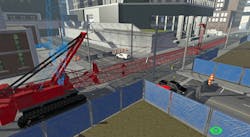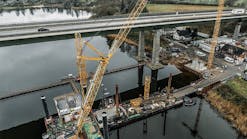Simulator Provides Crane Ratings for NYC
The responsibility of operating a crane sporting a 300-foot boom in North America’s most densely populated setting makes a New York City (NYC) crane license one of the most difficult of its kind to obtain in the United States. Even under ideal and open conditions, the operation of construction equipment has its risks. And within the confines of an urban environment such risks increase exponentially. International Union of Operating Engineers (IUOE) Local 14 members sit behind the controls of NYC’s heavy equipment ranging from cranes, excavators and drill rigs, to boom trucks, pavers, and forklifts.
As construction equipment becomes more sophisticated, the importance of equipment training is amplified. Under the direction of IUOE 14 business manager Ed Christian, training and safety have taken on new levels of importance and urgency. With a mission to maintain its rank as the highest skilled trade in the city’s construction industry, Local 14’s training center in Montrose, New York, provides instruction for new and advanced users alike. Among the school’s six training simulators is a 300-foot boom crane simulator developed by CM Labs.
“People recognize that this is a dangerous business; and we’ve made safety our top priority,” said training director Tom Gordon. A 30-year industry veteran, Gordon’s responsibilities include safety and training curriculum along with related equipment evaluation and purchase. “OSHA has very stringent safety guidelines and New York City has requirements that exceed those. Simply put, we’re responsible for the safety of our workforce and people in and around the job site, and we take that very seriously.”
As they increase in size and length, boom cranes become progressively difficult to maneuver. Driven by safety concerns, New York City imposed strict license requirements for operators of cranes with 300 feet or more boom length.
Crane safety training
Because large cranes are most often used within urban settings, training opportunities were not always available or practical. In the past, this entailed locating a specific crane in service and hoping to find time for closely supervised baptism-under-fire, instruction. “You can imagine how stressful and difficult it would be to make that your first time in the seat,” said Gordon.
Faced with a need to meet new regulatory requirements and enhance the skill set of experienced crane operators, New York City’s International Union of Operating Engineers (IUOE) Local 14 put its trust in CM Labs.
A few years earlier, while attending a tradeshow, Gordon had been introduced to CM Labs and the company’s simulators. Shocked at the level of detail and realism, he quickly recognized the value of simulators as training tools. Since that time, the union’s training school has acquired several CM Labs heavy equipment simulators.
“Experiencing the controls, forces, inertia, twisting, and movement of a crane, are critical to understanding the reaction differences between a 200-foot and 300-foot boom,” said Gordon. “Our top priority was to provide operators with detailed training for the procedures of erection and lay-down of a 300-foot boom or luffing jib. These are dangerous steps in crane operation, and we had to get it right.”
In fact, requirements were so exact and critical that some questioned whether such detail and complexity could be adequately simulated. “We were skeptical,” admitted Gordon. “We weren’t convinced that a simulator could realistically reproduce the angles, point of jackknife, controls, vision, rigging, loads, cables, and a hundred other things.”
Creating a training simulator that would provide a crane rating had never been done. Success would rely on capturing the real-world reactions of the complex equipment while reflecting the operator’s working knowledge of a specific crane type, model, and configuration.
“This was an extremely complex project,” noted CM Labs director of product strategy Drew Carruthers. “We modeled the crane’s inner workings exactly - every segment, every wire, each component. We had to identify what could behave how, and why; and then model those consequences exactly. Our simulations had to allow the equipment to be pushed to its limits safely without exceeding the tipping point.”
Engineering specifications and other information supplied by the manufacturer would help developers create a model of the crane – along with each of its individual components. This allowed Carruthers and his team to realistically capture the relationship between all the machine’s parts. This level of detail was used to identify and simulate the steps of what happens when everything goes well, along with the consequences when things don’t – and ensure that the simulator’s reaction would mirror that of the crane.
CM Labs delivered a custom simulator that met all requirements and exceeded expectations. What’s more, the simulator carries the distinction as the first and only virtual crane rating solution approved by the NYC Department of Buildings. Similarly, the manufacturer was so impressed that they are using the simulation model to help showcase the crane’s controls.
“This was truly a game changer,” said Gordon. “It’s such an efficient tool, it adds another dimension and is an excellent supplement to our already stringent training protocols. Our people spend days on the simulator; and I’m not talking about just new operators. These are licensed operators who haven’t operated cranes in that specific configuration and want to get comfortable with how it reacts.”
Adding the simulator to its training arsenal allows Local 14 to serve operators at all levels. “I think most simulators are used to train people who are just starting, apprentices, newcomers to the business,” explained Gordon. “We're now able to provide advanced training for our journeyman and licensed operators who have been running cranes for years.”
Bolstered by year-round training, Local 14 is maintaining a growing pool of 300’ certified crane operators. As a result, CM Labs is working to develop a similar simulator based on the specifications of a different crane manufacturer.
“The simulator works great and journeymen as well as trainees are impressed by the optics and realism,” concluded Gordon. “When it comes to training, you’re not just saving on fuel and equipment wear and tear - that’s a bonus and a big number. More importantly, you’re ensuring the safety of the instructor, operator, and others on the job site. But just as important, it allows us to actively promote crane operator training and safety throughout the industry.”
-CM Labs Simulations clients include IUOE, Kiewit, Liebherr, Mammoet, and Manitowoc.





